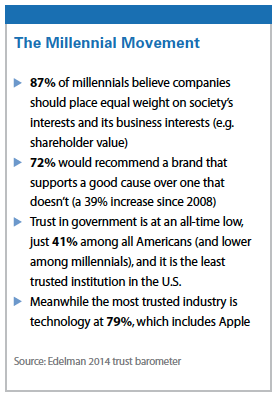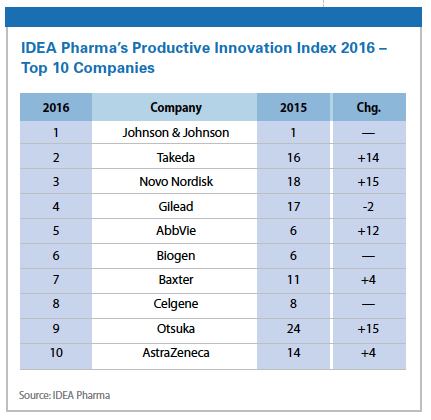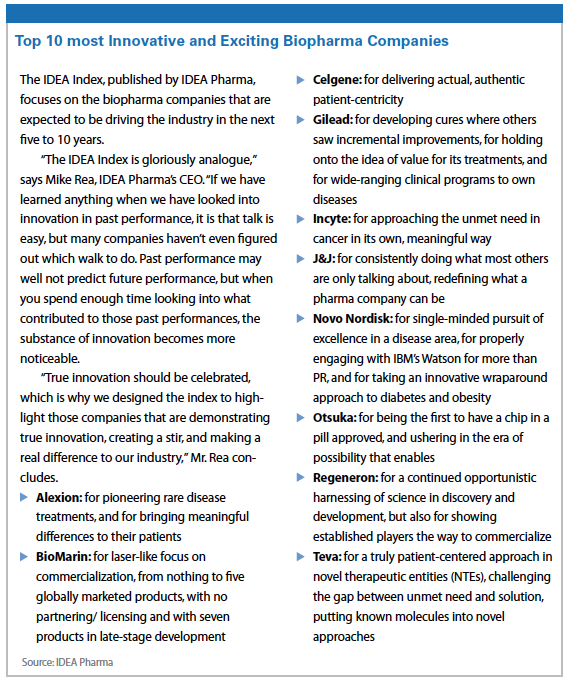Companies from Apple to Alphabet to Johnson & Johnson and IBM are driving innovative approaches to improving healthcare and patient care.
 Apple, which has clearly been a worldwide leader in innovation, is now also looking to “make a significant contribution to culture," says Jay Gronlund, president of The Pathfinder Group. He notes that Apple’s brand mission states “we’re on the face of the earth to make great products," and Apple has certainly proven itself, and now Tim Cook is broadening the Apple brand to also “enable customers to engage the world in more meaningful ways." This new focus adds to Apple’s entrenchment as a significant player in the IT life-sciences sector.
Apple, which has clearly been a worldwide leader in innovation, is now also looking to “make a significant contribution to culture," says Jay Gronlund, president of The Pathfinder Group. He notes that Apple’s brand mission states “we’re on the face of the earth to make great products," and Apple has certainly proven itself, and now Tim Cook is broadening the Apple brand to also “enable customers to engage the world in more meaningful ways." This new focus adds to Apple’s entrenchment as a significant player in the IT life-sciences sector.
Mr. Gronlund notes that millennials have been a key driving force behind Apple’s success, so it is not surprising that these emerging brand values of Apple like trust, human rights and dignity, environmentalism, and privacy are consistent with the passions of this younger target segment. And there is also a business rationale for this focus. As CEO Mr. Cook stated, these millennials represent a much bigger target market than religious conservatives, and it is critical for Apple to emotionally connect and bond with them, which is what branding is all about.
Could the pharmaceutical industry benefit from taking a page out of the Apple brand book? Perhaps, as the industry still struggles with a reputation issue, especially in light of recent negative attention brought about by Martin Shkreli’s actions.
One way that the industry could change the conversation, industry experts say, is by focusing on the innovative and breakthrough medicines in the pipeline and being brought to market for both chronic and orphan diseases.
IDEA Pharma, which ranks biopharmaceutical companies by their ability to successfully bring innovations to market, views Johnson & Johnson as being at the top of the industry for the fourth year running.
 The Productive Innovation Index measures, scores, and celebrates a company’s ability to deliver innovation to patients, by objectively evaluating performance data based on a rolling five-year period (2010-2015), and operates on the premise: if you gave the same molecule to two different companies in early phase, which would make the best of it?
The Productive Innovation Index measures, scores, and celebrates a company’s ability to deliver innovation to patients, by objectively evaluating performance data based on a rolling five-year period (2010-2015), and operates on the premise: if you gave the same molecule to two different companies in early phase, which would make the best of it?
The success of the Janssen Pharmaceutical Companies of Johnson & Johnson and its consolidation of first place across the past four years of rankings is driven largely by innovations in the field of oncology, immunology, neuroscience, and cardiovascular/metabolism.
Johnson & Johnson’s notable performers include Zytiga (prostate cancer), Imbruvica (chronic lymphocytic leukemia and mantle cell lymphoma (co-developed and co-marketed with Pharmacyclics, an AbbVie company), Simponi/Simponi Aria (rheumatoid arthritis), Stelara (psoriasis and psoriatic arthritis), Invega Sustenna, and Invega Trinza (schizophrenia).
Takeda was a major mover on the Index in 2016, IDEA Pharma notes, rising 14 places to take second place. The principal driver for this change is strong sales growth across the United States and emerging markets, having benefitted from a significant number of new drugs in the last 12 to 18 months, including Entyvio (ulcerative colitis and Crohn’s disease), Takecab (for acid-related GI disorders), Adcetris (lymphoma), and Brintellix (major depressive disorder).
Moving up 15 places to third place is Novo Nordisk. The company continues to occupy leadership positions in front-line therapy in type 1 diabetes (T1D) and have a significant share of the type 2 diabetes (T2D) market. This is largely due to strong performances from Victoza (T2D), Levemir (T1 and 2D), and the 2015 launch of Tresiba (for T1 and 2D).
Other high risers include AbbVie, which moved up 12 places to fifth and Otsuka, rising from 24th last year to assume ninth place.
IDEA Pharma’s CEO, Mike Rea, says Johnson & Johnson continues to be the most successful biopharmaceutical innovator globally. The company’s strategy of pairing externally sourced innovation with strong internal research, development, and commercialization capabilities has secured the company the top of the Productive Innovation Index for another year.
 “Johnson & Johnson’s strength in maximizing success per compound is in no small part due to the ability to match products to patient need," he says. “There is no gaming the Productive Innovation Index — serial success on the Index is achieved by discovering and developing meaningfully great medicines and getting those medicines to patients. It is wonderful to see a company of the scale of Johnson & Johnson that is able to maintain a consistently excellent innovation profile."
“Johnson & Johnson’s strength in maximizing success per compound is in no small part due to the ability to match products to patient need," he says. “There is no gaming the Productive Innovation Index — serial success on the Index is achieved by discovering and developing meaningfully great medicines and getting those medicines to patients. It is wonderful to see a company of the scale of Johnson & Johnson that is able to maintain a consistently excellent innovation profile."
Fast Company, which ranks the most innovative companies each year, has released its 2016 list. On its list of the world’s 50 most innovative companies in 2016 is Alphabet, the holding company, which was founded in 2015 to house Google and all of its Web-based properties, as well as the increasingly diverse real-world ventures the Internet behemoth was swelling to encompass, from driverless cars and life-extension research to high-speed Internet.
According to Fast Company, Alphabet was created as part of a bold restructuring through which co-founders Larry Page and Sergey Brin hope to nurture Google’s multifarious ventures into significant businesses, rather than hobbies that drag on Google’s earnings. Alphabet is no small gamble; Fast Company analysts say not all of its futuristic ideas will work, and visionary leaders may not be in large enough supply. But the co-founders’ willingness to reinvent themselves according to their growing ambitions almost 20 years into Google’s existence is a model worth studying for people looking to create big change in the world.
Companies on Fast Company’s biotech list are:
1. Novocure, for attacking tumors with electricity
2. Bristol-Myers Squibb, for treating tumors with T-cells
3. Amgen, for making cancer therapy go viral
4. Emerald Therapeutics, for building a testing lab in the cloud
5. Enteromedics, for disrupting the signals between the brain and stomach to fight obesity
6. Corgenix Medical, for speeding up the Ebola test
7. Oxford Performance Materials, for designing a better spine implant
8. Proteus Digital Health, for digitizing Abilify
9. 23Andme, for reinventing itself to get FDA approval
10. Aprecia Pharmaceuticals, for creating the first 3D-printed drug
On Fast Company’s healthcare list are:
1. Augmedix, for giving Google Glass a second life (in the doctor’s office)
2. MC10, for tracking patient vitals with an electronic tattoo
3. PillPack, for using clever alerts to remind customers to take their meds
4. The Parker Foundation, for hacking a new approach to making impactful donations
5. Johns Hopkins Applied Physics Laboratory, for building the bionic man, one arm at a time
6. UBiome, for drafting citizens to study what’s in their guts
7. Lybrate, for crowdsourcing a solution to India’s doctor shortage
8. Enlitic, for using AI to accurately assess radiology results
9. CVS Health, for reinventing the pharmacy
10. IBM, for opening a hub of health data that doctors and startups can build on (PV)


















